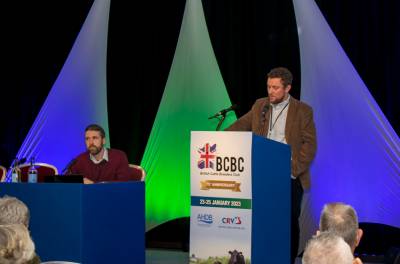

Hybrid vigour in the dairy herd means that one plus one equals three, says Sean Chubb of LIC. Speaking at the BCBC conference he outlined how cross-breeding – and other changes – were helping to save the dairy unit at Walford College.
Increasing the value of milk while also drastically reducing costs were twin aims at the centre of Sean Chubb and Tom Moore’s plans at Walford College. Together they explained those plans to delegates at the BCBC conference.
Tom took over management of the college farm in 2018 and recognised numerous challenges with costs and herd health. Together with Sean Chubb, Lead Pasture to Profit Consultant with LIC he implemented some plans for huge change. This included turning the cows out for nine to ten months per year, creating an autumn calving block, increasing milk from forage and changes to youngstock management. These then led on to decisions to move to a milk solids-based contract and to implement a cross breeding policy, bringing in Jersey genetics.
“The biggest reason for this was hybrid vigour,” said Sean. “To put it simply, hybrid vigour means one plus one equals three. In the first year we halved our losses and we’ve been progressively getting better and better. The last couple of seasons have been around break-even.
“Adding value to milk is just starting to happen and hopefully as more of the genetics come through, we will be able to lift the value of the milk price and further improve profitability at the same time.”
Flintshire farmer Rhys Davies shared his learning from a Farming Connect funded study tour which saw him visit six grass-based herds in Ireland. His 100-cow Ffrwd herd is predominantly Holstein Friesian with some crossbred cows introduced in the early 2000s when he brought in some New Zealand Friesian and Kiwi Cross genetics. This was the most viable approach for his business as sexed semen wasn’t fully available at that time. The study trip enabled him to explore Irish farmer’s use of the EBI. “We had reps on the yard telling us how good the different indexes were, so we were using a bit of everything. We didn’t really have a goal but knew what sort of cow we wanted.”
Amongst his key findings were that the EBI made it possible to breed “a black and white cow with Jersey like solids and cross-bred like fertility”. The trip inspired him to examine the management of his own herd in detail and implement changes including weighing and linear scoring cows and genomic testing all heifer calves. He found that his smaller cows were the most efficient.
“Not doing genomic testing on heifer calves would be like not walking the paddocks once a week. It will just leave you blind not knowing what to do.” He looks for protein percentage, which is more important to him than kilos. Fertility was also very important he said. Now he uses the AHDB herd genetic report and PLIs to make breeding decisions but is glad of the experience and learning from his study trip. “We’re top 1% for fat and protein percent and fertility, but there’s still lots of things for us to improve.”
Photography Credit @Jenny Wood Photography